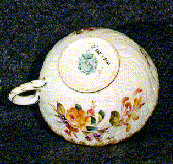Identifying an artifact from the Victorian Era. Also known as Victoriana
Lesson #1 How to identify a Victorian era porcelain teacup.

i.e. Sarguumemnes.
Visit a historic site where there is a known collection of historical artifacts. Find out what
kind of
collection they have and ask if there is dinnerware collection of porcelain items.
Materials:
Clipboard or writing pad, digital camera, regular camera (or disposable), pencil, eraser, lights, grey paper backdrop (60lb paper), completed permission forms, transportation, access to a historic site.
Steps:
Arrive at historic/heritage site. Pick artifact for research. Note any distinguishing marks on the bottom of the porcelain cup. Photograph the sides and underside of the cup.
Your pictures MUST include a photograph of the cup.
This is where you will find the manufacturer's stamp. Sometimes you
will find only a scrape or a design... this is also a manufacturer's stamp. This stamp will date a porcelain cup and gives clues as to where and by whom it was manufactered.
The cup presented here is not identifed by country or manufacturers name. It would be much easier if this cup was stamped "Made in England" by "Wedgwood and Sons". But it doesn’t. Collect all the necessary visual identification from the cup that is possible.
Develop your pictures of the cup. Now it is time to begin your search. Until recently, information about manufacturer stamps was
unavailable on the Internet. So for now it all starts in the library.
Here is a list of books that you will need to find to begin your search for the insignia or stamp on the bottom of this cup.
Source:
- Poche, E., Porcelain Marks of the World. New York: Arco Publishing Company, 1974.
- Chaffers, W., Marks and Monograms on European and Oriental Pottery and Porcelain. Los Angeles: Borden Publishing Co.,1948.
Start by holding your picture in one hand up to the designs presented in the artifact book. Flip patiently until it appears you find one that matches.
Find the name associated with this stamp and use the other book to cross reference with colors and styles. It appears you have a match!

Photocopy the page in the book with the matching stamp description. It appears this item was made in Germany.
Synopsis:
What does that tell you about the people that owned the item or artifact? It tells you that because they lived in Victoria, B.C., they had a connection with Germany of some sort. Maybe the local store brought in shipments of teacups from places in the world that were more advanced in manufacturing these items than Canada.
Maybe the owner loved the design during a visit to Germany and brought it home. Or perhaps it was a wedding gift for one of the residents of Point Ellice House. Whatever the case, you at least know that this artifact travelled a long distance from Germany, many
years ago, to be found in Victoria, British Columbia with the O’Reilly family. You also know if it was used, that the O’Reilly family enjoyed tea as well!

